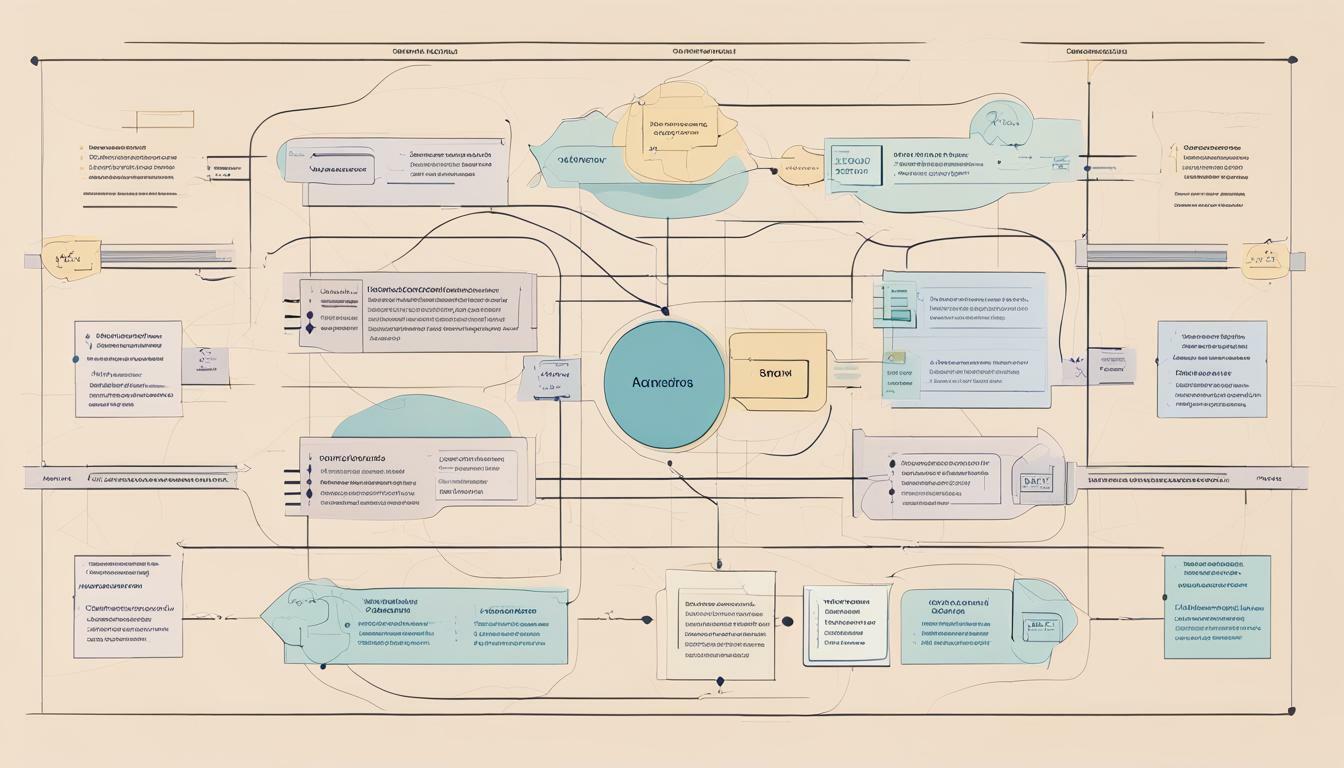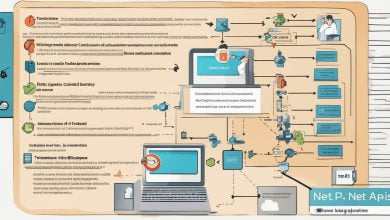
In today’s rapidly evolving business landscape, it is crucial to stay ahead of the curve. One way to do this is by understanding and embracing Conway’s Law, the principle that organizational structure reflects software design. This principle offers valuable insights into how businesses can optimize their structures and processes to drive innovation.
Conway’s Law is a powerful tool for businesses to improve their software design and development practices. By recognizing the relationship between organizational structure and software design, businesses can create more effective teams and processes that lead to better products and services. In this article, we will explore the basics of Conway’s Law, its impact on software design, and how it can be applied in agile methodology and software project management.
Key Takeaways
- Conway’s Law is a principle that states that organizational structure reflects software design.
- Understanding this relationship can help businesses optimize their processes and drive innovation.
- The application of Conway’s Law can be seen in agile methodology and software project management.
The Basics of Conway’s Law
If you’re not familiar with Conway’s Law, it may seem like an abstract concept at first. But in reality, it’s something that affects all businesses that develop software. Simply put, Conway’s Law states that the structure of an organization will be reflected in the software it produces. This means that the way a company is organized, its communication channels, and collaboration methods will all impact the design and architecture of the software it creates.
The implications of this law are far-reaching and complex. But at its core, Conway’s Law highlights the need for organizations to pay close attention to their internal structures and processes if they want to produce high-quality software. By carefully designing their organizational structure to align with their software development goals, businesses can optimize their team dynamics and foster an environment of innovation and growth.
The Origins of Conway’s Law
Conway’s Law was first coined by computer programmer Melvin Conway in 1968. Conway observed that the way developers worked together on a project had a significant impact on the final product. He noted that if developers were organized into small, autonomous teams, they tended to produce software that was modular and easy to maintain. Conversely, if developers were organized into larger, more centralized teams, the resulting software tended to be more monolithic and difficult to modify.
Conway’s Law is not just a historical curiosity; it continues to have relevance today, particularly in the context of agile software development. By aligning their organizational structures with the agile methodology, businesses can better adapt to changing market conditions and quickly respond to customer needs. This, in turn, can drive innovation and improve overall business performance.
Key Principles of Conway’s Law
Conway’s Law is founded on several key principles, including:
- The communication channels within an organization have a direct impact on the design of the software it produces.
- The modularity of software is directly related to the modularity of the organization producing it.
- The boundaries between different software modules tend to mirror the boundaries between different teams or departments within an organization.
Together, these principles highlight the need for businesses to prioritize effective communication, collaboration, and autonomy within their organizational structures if they want to produce high-quality software.
The Relationship Between Organizational Structure and Software Architecture
Conway’s Law, the principle that the design of a company’s software systems will reflect its organizational structure, holds significant implications for software architecture. As the structure of a company changes, so too should its software design. This connection underscores the importance of maintaining an agile approach to organizational structure and software development to ensure that both evolve in tandem.
Companies whose organizational structures are siloed or fragmented tend to have software systems that mirror this structure. For example, a company with a product-based organizational structure is likely to have software systems that are similarly organized around specific products. Conversely, companies with a matrix organizational structure, in which employees are organized by function and project, tend to have software systems that are also functionally organized.
Mirroring in software design is not always a bad thing, however. In fact, it can be a strategic advantage when used purposefully. When companies adopt a modular approach to software design, breaking down large systems into smaller, reusable components, they can more easily align software design with organizational structure. This approach enables the creation of cross-functional teams that can quickly adapt to changes in the company’s structure and priorities.
| Organizational Structure | Software Design Characteristics |
|---|---|
| Product-based | Product-specific software systems |
| Matrix-based | Functionally organized software systems |
| Hierarchical | Software systems organized by hierarchy |
Software developers can leverage Conway’s Law to inform decisions around software architecture. By designing software systems that align with the company’s organizational structure, developers can better understand how changes to structure will impact the software, and vice versa. This helps to avoid costly redesigns and ensure that software systems remain aligned with the needs of the business as it evolves.
Understanding the relationship between organizational structure and software design is key to managing software development projects effectively. Project managers need to be aware of how changes to the company’s organizational structure will impact the software being developed, and how the development process can influence the structure of the organization. By taking an agile, modular approach to software development, and maintaining an open dialogue with business leaders, project managers can help ensure that software design and organizational structure remain in sync.
The Importance of Alignment
Ultimately, the key takeaway is that alignment between organizational structure and software design is critical. Companies that recognize the relationship between the two and actively work to maintain alignment are better positioned to drive growth, innovation and ultimately achieve business success.
Applying Conway’s Law in Agile Methodology
Conway’s Law aligns well with agile methodology, which emphasizes collaboration and cross-functional teams. By breaking software development into smaller iterations, agile methodology allows teams to make changes more easily and provides opportunities for continuous feedback. This approach supports the principles of Conway’s Law, as it encourages teams to be organized around specific features or functions of the software.
One way that agile methodology aligns with Conway’s Law is through regular stand-up meetings, where team members share progress updates and discuss any challenges they are facing. This allows team members to stay aligned on the project’s goals, and ensures that the software being developed meets the needs of the organization.
Another way that agile methodology aligns with Conway’s Law is through the use of cross-functional teams. By having individuals with different skill sets working together, teams are able to create more cohesive software solutions. This approach also helps to ensure that the entire team is invested in the project, which can lead to better communication and collaboration.
Collaboration and Communication
Communication is key in both agile methodology and Conway’s Law. Agile teams should have regular conversations with their customers to ensure that their software meets their needs. This approach aligns with Conway’s Law, which suggests that the organization’s structure will influence the design of the software. By having regular conversations with customers, teams can ensure that they are designing software that meets the needs of the organization.
Additionally, agile teams should be focused on collaboration. This includes collaboration between team members, as well as with other departments within the organization. By working together, teams are able to develop software more efficiently and effectively.
Iterative Development
Agile methodology emphasizes iterative development, with teams developing software in short sprints. This approach aligns well with Conway’s Law, which suggests that the design of the software will reflect the organizational structure. By breaking development into smaller iterations, teams can align the design of the software with the structure of the organization.
Iterative development also allows teams to make changes more easily. By regularly testing and receiving feedback on their software solutions, teams are able to make improvements quickly, ensuring that their software meets the needs of the organization.
Overall, Conway’s Law and agile methodology share many similarities. The emphasis on collaboration, communication, and iterative development in agile methodology aligns well with the principles of Conway’s Law. By leveraging this principle, teams can develop software solutions that reflect the structure of the organization, leading to more effective software development.
Managing Software Projects with Conway’s Law in Mind
Managing software projects can be challenging, especially when it comes to aligning the organizational structure with software design. However, by leveraging the principles of Conway’s Law, project managers can optimize team dynamics, communication, and overall project success.
Here are some strategies and best practices for software project management with Conway’s Law in mind:
- Build cross-functional teams: As Conway’s Law suggests, the architecture of a software system will mirror the communication patterns of the team developing it. Therefore, it’s crucial to build cross-functional teams that promote collaboration and communication across departments and functional areas. This will not only facilitate better software design but also improve team dynamics and overall project success.
- Encourage iterative development: Conway’s Law also suggests that the structure of a software system will mirror the team’s organization. Therefore, agile methodologies, which emphasize iterative development and continuous feedback, align well with the principles of Conway’s Law. By adopting iterative development practices, project managers can ensure that the software design and organizational structure evolve in tandem, leading to more effective software development.
- Promote open communication: Effective communication is crucial for successful software development, as it facilitates collaboration, feedback, and problem-solving. As such, project managers should encourage open communication channels across the team and organizational levels. This will not only enable better software design but also help overcome any challenges arising from misaligned organizational structures.
Overcoming Challenges and Maximizing Benefits
Applying Conway’s Law requires a fundamental shift in organizational thinking. Embracing this principle means abandoning traditional hierarchies and embracing a more collaborative and decentralized approach to software design and development.
While this approach offers many benefits, it also poses some challenges. One significant challenge is overcoming the resistance to change from both management and team members. Conway’s Law requires a significant cultural shift, and this transition can be difficult and time-consuming.
Another challenge is ensuring that teams are aligned with the company’s overall strategic goals. Conway’s Law emphasizes team autonomy, which can sometimes result in teams working on tasks that are not aligned with the company’s mission. It is crucial to strike a balance between team autonomy and company alignment.
Despite these challenges, the benefits of applying Conway’s Law are substantial. By aligning organizational structure with software design and development, companies can foster a culture of collaboration, innovation, and agility. This approach leads to faster delivery times, increased customer satisfaction, and overall business growth.
To maximize the benefits of Conway’s Law, companies should prioritize transparency and communication. Team members should be empowered to voice their concerns and ideas, and management should actively listen and respond. By creating an environment of trust and openness, teams can work together to achieve their goals and drive business success.
Future Trends and Implications
As businesses continue to evolve and adapt to the ever-changing technological landscape, the principles of Conway’s Law are becoming increasingly relevant. Organizations are recognizing the need for flexible and adaptable structures that can accommodate the demands of modern software development.
One emerging trend is the rise of decentralized, autonomous teams. These teams operate with a high degree of autonomy, focusing on specific projects and collaborating with other teams as needed. This approach allows for greater agility and flexibility, aligning with the principles of Conway’s Law.
Another trend is the adoption of cloud-based technologies and platforms. Cloud computing enables organizations to rapidly deploy and scale software systems, facilitating decentralized team collaboration and dynamic organizational structures.
Additionally, as machine learning and artificial intelligence continue to advance, the relationship between organizational structure and software design may become even more intertwined. These technologies have the potential to optimize software systems and streamline organizational processes, further emphasizing the importance of understanding Conway’s Law.
Conclusion
In conclusion, Conway’s Law serves as a crucial insight into the relationship between organizational structure and software design. By understanding and leveraging this principle, businesses can optimize their team dynamics, improve communication, and drive growth and innovation.
As software development practices continue to evolve and adapt to changing business needs, it is essential for organizations to stay attuned to the implications of Conway’s Law. By embracing and integrating this principle into their management and development strategies, businesses can enhance their ability to deliver effective and successful software projects.
Embracing Conway’s Law for the Future
Looking forward, the continued application of Conway’s Law will undoubtedly shape the future of software development and organizational design. As emerging technologies and evolving business practices continue to transform the landscape of software development, organizations must remain committed to embracing and leveraging the insights provided by this principle.
Ultimately, the success of any software project depends on the effective integration of both organizational structure and software design. By recognizing and embracing the relationship between these two critical components, businesses can unlock the full potential of their software development initiatives and drive sustainable growth and innovation.
FAQ
Q: What is Conway’s Law?
A: Conway’s Law is a principle that suggests that the design of software systems is heavily influenced by the communication structures and organizational hierarchies of the teams developing them.
Q: How does Conway’s Law relate to organizational structure?
A: Conway’s Law highlights the direct connection between the organizational structure of a company and the design and architecture of its software systems. The way teams are organized and the ways they communicate and collaborate impact the resulting software design.
Q: How does Conway’s Law apply to software architecture?
A: Conway’s Law suggests that the structure and communication patterns within a company will be reflected in the design of its software architecture. This means that the software architecture tends to mirror the organization’s hierarchy, departments, and communication channels.
Q: How can Conway’s Law be applied in agile methodology?
A: Conway’s Law can be applied in agile methodology by forming cross-functional teams that mimic the desired software architecture. By organizing teams to reflect the desired architecture, communication and collaboration are optimized, leading to more effective software development practices.
Q: How can project managers leverage Conway’s Law in software projects?
A: Project managers can leverage Conway’s Law by aligning the organization’s structure with the desired software architecture. By understanding how the two are interconnected, project managers can optimize team dynamics, communication, and project success.
Q: What are the challenges of aligning organizational structure with software design?
A: Aligning organizational structure with software design can be challenging because it requires breaking down silos and fostering effective communication across teams. It can also be difficult to change existing hierarchy and processes. However, the benefits of embracing Conway’s Law can outweigh these challenges.
Q: What are the future trends and implications of Conway’s Law?
A: The future trends and implications of Conway’s Law are still evolving. As technology and business practices continue to advance, the application of Conway’s Law may change as well. It is important to stay updated on emerging technologies and evolving organizational structures to fully leverage this principle.








